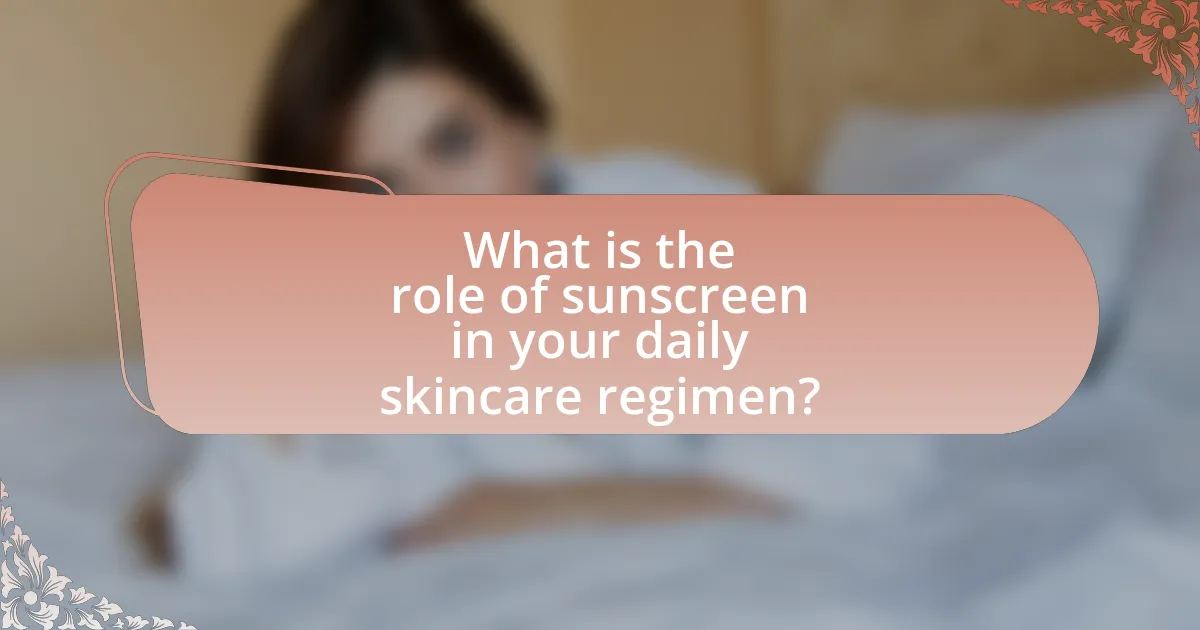Sunscreen plays a vital role in daily skincare regimens by protecting the skin from harmful ultraviolet (UV) radiation, which can lead to skin cancer and premature aging. The article outlines how sunscreen functions by absorbing, reflecting, or scattering UV rays, and emphasizes the importance of using broad-spectrum products with an SPF of 30 or higher. It discusses the different types of UV radiation, the significance of formulation and application techniques, and the necessity of daily use to prevent long-term skin damage. Additionally, the article addresses common misconceptions about sunscreen and provides best practices for effective application and incorporation into skincare routines.

What is the role of sunscreen in your daily skincare regimen?
Sunscreen serves as a critical protective barrier in daily skincare regimens by shielding the skin from harmful ultraviolet (UV) radiation. Regular application of sunscreen reduces the risk of skin cancer and prevents premature aging, including wrinkles and sunspots, which are caused by UV exposure. According to the American Academy of Dermatology, using a broad-spectrum sunscreen with an SPF of 30 or higher can significantly lower the risk of developing skin cancer and other skin damage.
How does sunscreen protect your skin?
Sunscreen protects your skin by absorbing, reflecting, or scattering harmful ultraviolet (UV) radiation from the sun. This protective mechanism prevents UV rays from penetrating the skin, which can lead to sunburn, skin aging, and an increased risk of skin cancer. Specifically, broad-spectrum sunscreens block both UVA and UVB rays, with SPF ratings indicating the level of protection against UVB rays. Research shows that regular use of sunscreen can reduce the risk of developing melanoma by 50% and other skin cancers by 40%, highlighting its critical role in skin health.
What are the different types of UV radiation and their effects on skin?
There are three main types of UV radiation: UVA, UVB, and UVC, each with distinct effects on the skin. UVA radiation penetrates deeply into the skin, leading to premature aging and increased risk of skin cancer by damaging collagen and DNA. UVB radiation primarily affects the outer layer of the skin, causing sunburn and playing a significant role in the development of skin cancer. UVC radiation is mostly absorbed by the Earth’s atmosphere and does not significantly impact human skin under normal conditions. The American Academy of Dermatology states that both UVA and UVB rays contribute to skin damage, emphasizing the importance of sunscreen that protects against both types for effective skin care.
How does sunscreen formulation impact its effectiveness?
Sunscreen formulation significantly impacts its effectiveness by determining the type and concentration of active ingredients, which influence UV protection levels. For instance, formulations containing broad-spectrum ingredients like zinc oxide or titanium dioxide provide protection against both UVA and UVB rays, while chemical filters may vary in their efficacy against different wavelengths. Additionally, the formulation’s texture, such as lotion, cream, or gel, affects application consistency and coverage, which are critical for achieving the labeled SPF. Studies have shown that proper application of a sufficient amount of sunscreen, typically 2 mg/cm², is essential for optimal protection, highlighting that formulation also affects user compliance and effectiveness in real-world scenarios.
Why is daily sunscreen application important?
Daily sunscreen application is important because it protects the skin from harmful ultraviolet (UV) radiation, which can lead to skin cancer, premature aging, and other skin damage. Research indicates that regular use of sunscreen can reduce the risk of developing melanoma by 50% and non-melanoma skin cancers by 40%. Additionally, sunscreen helps prevent photoaging, which includes wrinkles and sunspots, by blocking both UVA and UVB rays. Therefore, incorporating sunscreen into a daily skincare regimen is essential for maintaining skin health and preventing long-term damage.
What are the long-term effects of sun exposure on skin health?
Long-term sun exposure significantly damages skin health, leading to premature aging, skin cancer, and other skin disorders. Chronic ultraviolet (UV) radiation exposure causes photoaging, characterized by wrinkles, loss of elasticity, and pigmentation changes. According to the American Academy of Dermatology, approximately 90% of skin aging is attributed to sun exposure. Additionally, prolonged UV exposure increases the risk of skin cancers, including melanoma, basal cell carcinoma, and squamous cell carcinoma, with the Skin Cancer Foundation noting that one in five Americans will develop skin cancer by age 70. These effects underscore the importance of protective measures, such as sunscreen, to mitigate long-term skin damage.
How does sunscreen help prevent skin aging and damage?
Sunscreen helps prevent skin aging and damage by blocking harmful ultraviolet (UV) radiation from the sun. UV radiation is a significant factor in skin aging, contributing to wrinkles, fine lines, and pigmentation changes. Studies show that regular use of broad-spectrum sunscreen can reduce the risk of photoaging by up to 24% over time. Additionally, sunscreen protects against skin cancers, which can arise from prolonged UV exposure. The American Academy of Dermatology emphasizes that daily application of sunscreen is crucial for maintaining skin health and preventing premature aging.
What factors should you consider when choosing a sunscreen?
When choosing a sunscreen, consider the SPF rating, broad-spectrum protection, water resistance, skin type compatibility, and ingredient safety. The SPF rating indicates the level of protection against UVB rays, with higher numbers providing greater protection. Broad-spectrum protection ensures defense against both UVA and UVB rays, which is crucial for preventing skin damage and aging. Water resistance is important for maintaining effectiveness during sweating or swimming, with products typically rated for 40 or 80 minutes. Skin type compatibility is essential; for example, individuals with oily skin may prefer gel-based sunscreens, while those with dry skin might opt for cream formulations. Lastly, ingredient safety is vital; look for mineral-based sunscreens containing zinc oxide or titanium dioxide, which are generally considered safer and less irritating than chemical filters.
What are the differences between chemical and physical sunscreens?
Chemical sunscreens absorb UV radiation through their chemical ingredients, while physical sunscreens contain mineral ingredients that sit on the skin’s surface and reflect UV rays. Chemical sunscreens typically include compounds like avobenzone and octisalate, which can cause skin irritation in some individuals. In contrast, physical sunscreens often contain zinc oxide or titanium dioxide, which are less likely to irritate sensitive skin. Studies indicate that physical sunscreens provide immediate protection upon application, whereas chemical sunscreens require about 20 minutes to become effective.
How do SPF ratings influence your sunscreen choice?
SPF ratings significantly influence sunscreen choice by indicating the level of protection against UVB rays. Higher SPF ratings, such as SPF 30 or SPF 50, provide greater protection, blocking approximately 97% and 98% of UVB rays, respectively. This information helps consumers select a sunscreen that aligns with their skin type, sun exposure duration, and activity level, ensuring adequate protection against sunburn and long-term skin damage. Studies show that individuals using higher SPF products are less likely to experience sunburn, reinforcing the importance of SPF ratings in making informed sunscreen choices.
How can you effectively incorporate sunscreen into your skincare routine?
To effectively incorporate sunscreen into your skincare routine, apply it as the final step after moisturizer and before makeup. This ensures that the sunscreen forms a protective barrier on your skin, maximizing its efficacy. Dermatologists recommend using a broad-spectrum sunscreen with at least SPF 30 to protect against both UVA and UVB rays, as studies show that consistent use can significantly reduce the risk of skin cancer and premature aging. For optimal results, reapply sunscreen every two hours, especially if you are outdoors or sweating, to maintain protection throughout the day.
What is the best order to apply sunscreen in your skincare regimen?
The best order to apply sunscreen in your skincare regimen is after moisturizer and before makeup. Sunscreen should be the last step in your skincare routine to ensure it forms an effective barrier against UV rays. According to the American Academy of Dermatology, applying sunscreen after moisturizer allows it to adhere properly to the skin, maximizing its protective benefits.
How often should you reapply sunscreen throughout the day?
You should reapply sunscreen every two hours throughout the day. This recommendation is supported by the American Academy of Dermatology, which states that sunscreen effectiveness diminishes over time, especially when exposed to water, sweat, or friction. For optimal protection, it is essential to follow this guideline to maintain a consistent level of defense against harmful UV rays.
What are common misconceptions about sunscreen?
Common misconceptions about sunscreen include the belief that it is unnecessary on cloudy days, that a higher SPF provides significantly better protection, and that sunscreen is only needed during summer. Research indicates that up to 80% of UV rays can penetrate clouds, making sunscreen essential regardless of weather conditions. Additionally, while higher SPF numbers do offer more protection, the difference is marginal; SPF 30 blocks about 97% of UVB rays, while SPF 50 blocks about 98%. Lastly, UV exposure occurs year-round, so daily application is crucial for skin health, even in winter months.
Why do some people believe they don’t need sunscreen on cloudy days?
Some people believe they don’t need sunscreen on cloudy days because they underestimate the intensity of ultraviolet (UV) rays, which can penetrate clouds. Research indicates that up to 80% of UV rays can reach the earth’s surface on overcast days, leading to skin damage even without direct sunlight. This misconception often stems from a lack of awareness about UV radiation and its effects, as well as the visual perception that cloudy weather equates to reduced sun exposure.
How does makeup with SPF compare to traditional sunscreen?
Makeup with SPF provides some level of sun protection but is generally less effective than traditional sunscreen. Traditional sunscreen is specifically formulated to offer broad-spectrum protection against UVA and UVB rays, often with higher SPF ratings and more consistent application coverage. In contrast, makeup with SPF may not provide adequate protection due to factors such as insufficient application amount, uneven distribution, and the potential for makeup to wear off throughout the day. Studies indicate that to achieve the SPF listed on makeup products, one would need to apply a much thicker layer than typically used, which is often impractical. Therefore, while makeup with SPF can be a supplementary option, it should not replace traditional sunscreen for optimal sun protection.
What are some best practices for using sunscreen daily?
Daily sunscreen application is essential for effective skin protection against UV radiation. To maximize its benefits, apply a broad-spectrum sunscreen with an SPF of at least 30, ensuring it protects against both UVA and UVB rays. Use about one ounce, or a shot glass full, to cover all exposed skin, including the face, neck, and ears. Reapply every two hours, or more frequently if swimming or sweating, as studies indicate that consistent reapplication significantly enhances protection. Additionally, apply sunscreen 15 minutes before sun exposure to allow for proper absorption. Following these practices can reduce the risk of skin cancer and premature aging, as supported by research from the American Academy of Dermatology, which emphasizes the importance of daily sunscreen use in preventing skin damage.
How can you ensure even application of sunscreen on your skin?
To ensure even application of sunscreen on your skin, apply a sufficient amount, typically about a nickel-sized dollop for the face and a shot glass full for the body. This quantity allows for adequate coverage, which is essential since studies indicate that most people apply only 25-50% of the recommended amount, leading to reduced effectiveness. Use your fingers to spread the sunscreen evenly across all exposed areas, including hard-to-reach spots, and reapply every two hours or immediately after swimming or sweating to maintain protection.
What tips can help you remember to apply sunscreen regularly?
To remember to apply sunscreen regularly, establish a daily routine that incorporates sunscreen application at the same time each day, such as after brushing your teeth in the morning. This consistency helps reinforce the habit. Research indicates that habits formed through consistent cues are more likely to be maintained; for example, a study published in the journal “Health Psychology” found that pairing a new behavior with an existing routine significantly increases adherence. Additionally, setting reminders on your phone or using a calendar alert can serve as effective prompts to ensure sunscreen is applied daily.


